Legal Report: Sex Discrimination at Workplace-Controversy ASS0711
VerifiedAdded on 2023/06/16
|9
|2210
|106
Report
AI Summary
This report provides an overview of sex discrimination in the workplace, focusing on the challenges faced by women. It defines direct and indirect discrimination, referencing the Equality Act 2010 and the Sex Discrimination Act 1975. The report analyzes case law, including Thompson v Scancrown Ltd and Bilka-Kaufhaus GmbH v Karin Weber von Hartz, to illustrate the application of these laws. The conclusion summarizes the key findings, and the recommendations suggest that companies ensure equal job opportunities and flexible working hours for women, adhering to employment laws to foster a fair work environment. Desklib offers similar solved assignments and study resources for students.
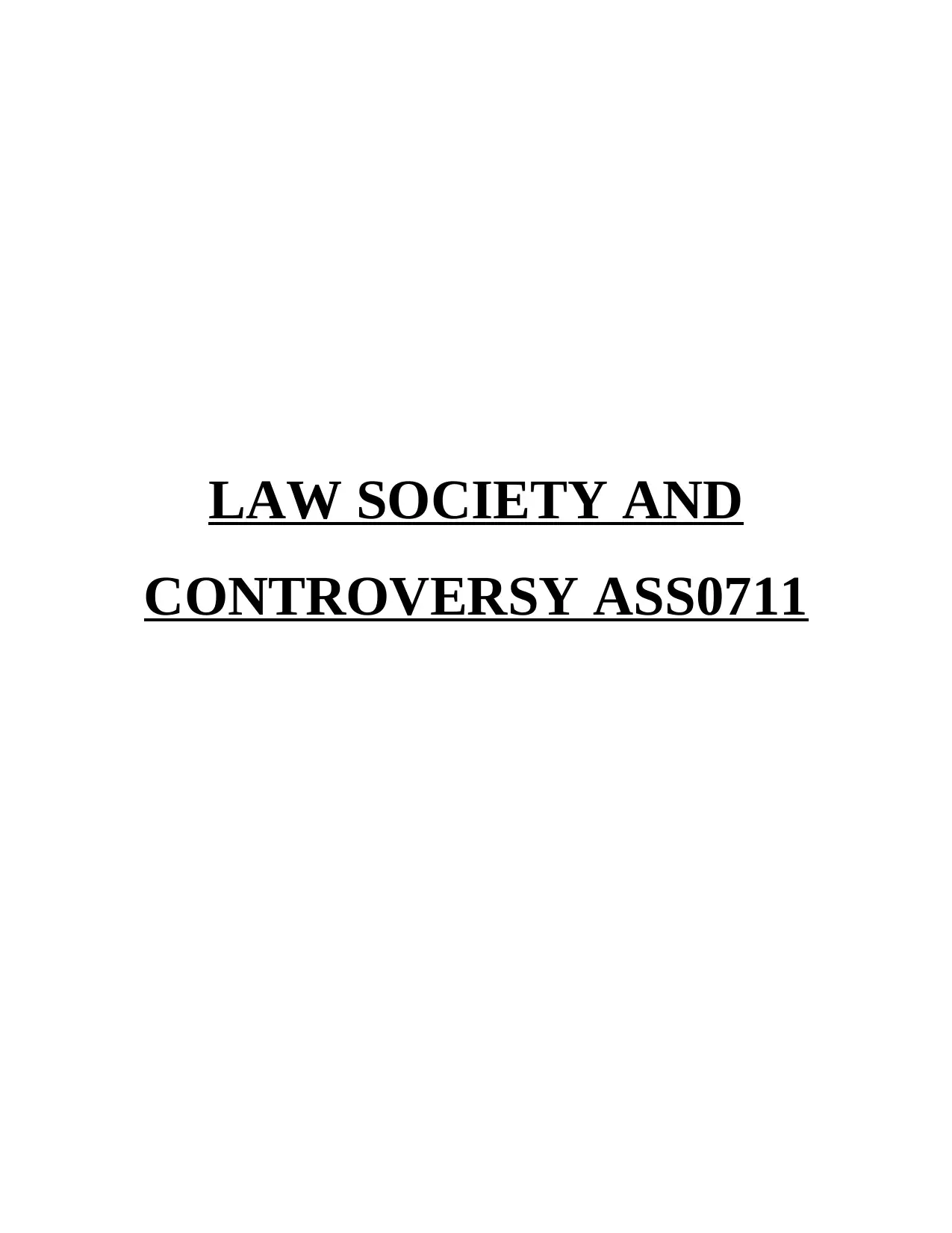
LAW SOCIETY AND
CONTROVERSY ASS0711
CONTROVERSY ASS0711
Paraphrase This Document
Need a fresh take? Get an instant paraphrase of this document with our AI Paraphraser
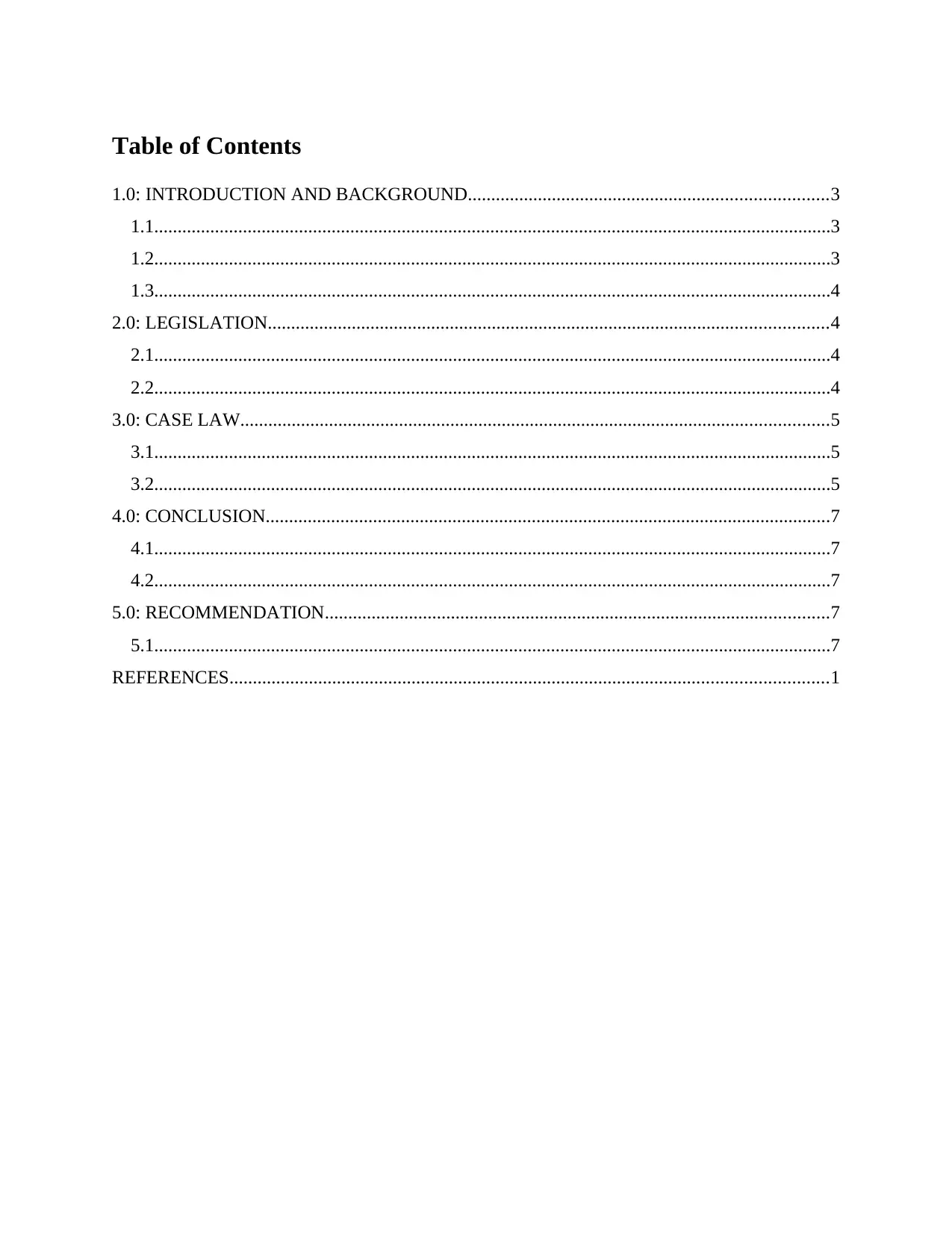
Table of Contents
1.0: INTRODUCTION AND BACKGROUND.............................................................................3
1.1.................................................................................................................................................3
1.2.................................................................................................................................................3
1.3.................................................................................................................................................4
2.0: LEGISLATION........................................................................................................................4
2.1.................................................................................................................................................4
2.2.................................................................................................................................................4
3.0: CASE LAW..............................................................................................................................5
3.1.................................................................................................................................................5
3.2.................................................................................................................................................5
4.0: CONCLUSION.........................................................................................................................7
4.1.................................................................................................................................................7
4.2.................................................................................................................................................7
5.0: RECOMMENDATION............................................................................................................7
5.1.................................................................................................................................................7
REFERENCES................................................................................................................................1
1.0: INTRODUCTION AND BACKGROUND.............................................................................3
1.1.................................................................................................................................................3
1.2.................................................................................................................................................3
1.3.................................................................................................................................................4
2.0: LEGISLATION........................................................................................................................4
2.1.................................................................................................................................................4
2.2.................................................................................................................................................4
3.0: CASE LAW..............................................................................................................................5
3.1.................................................................................................................................................5
3.2.................................................................................................................................................5
4.0: CONCLUSION.........................................................................................................................7
4.1.................................................................................................................................................7
4.2.................................................................................................................................................7
5.0: RECOMMENDATION............................................................................................................7
5.1.................................................................................................................................................7
REFERENCES................................................................................................................................1
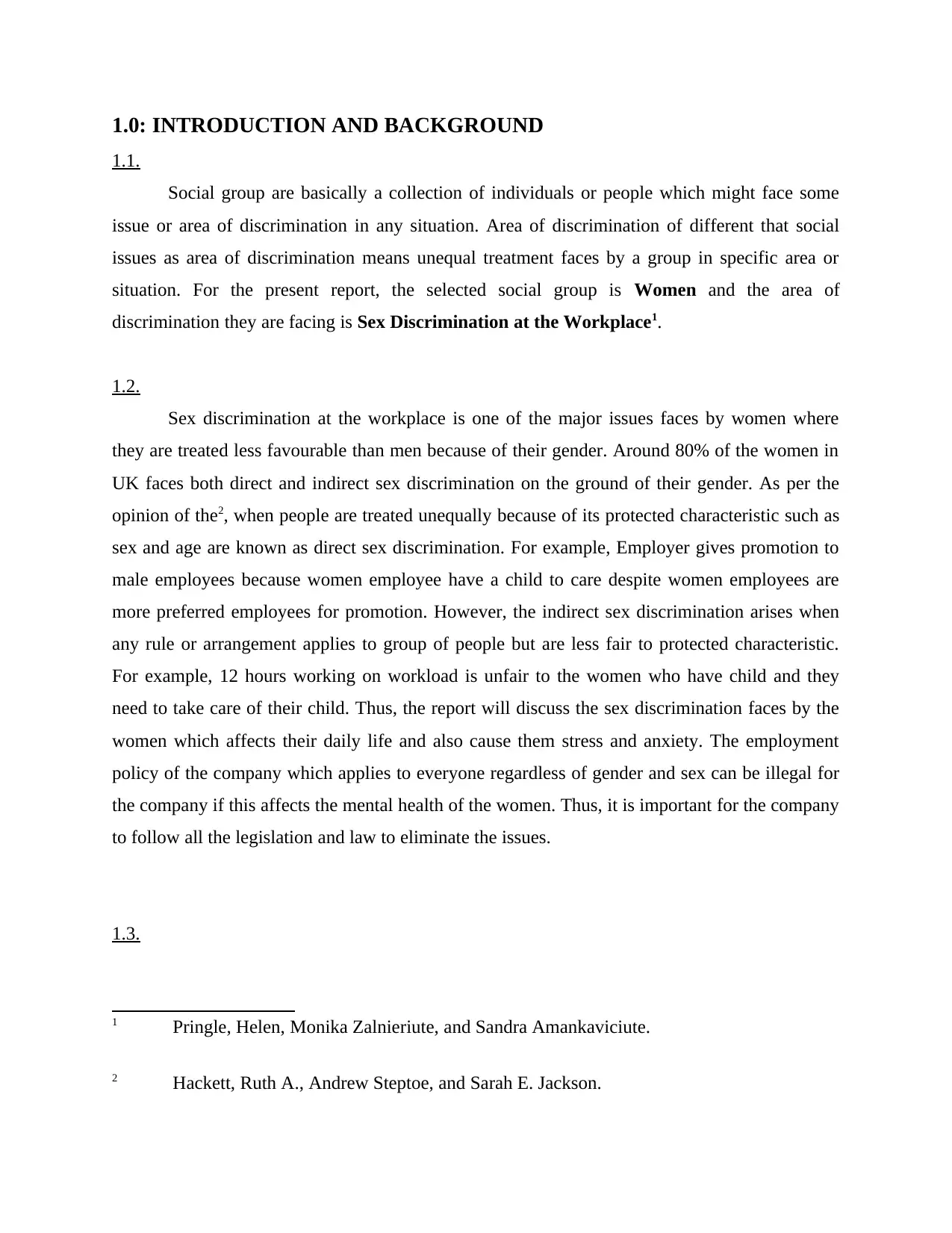
1.0: INTRODUCTION AND BACKGROUND
1.1.
Social group are basically a collection of individuals or people which might face some
issue or area of discrimination in any situation. Area of discrimination of different that social
issues as area of discrimination means unequal treatment faces by a group in specific area or
situation. For the present report, the selected social group is Women and the area of
discrimination they are facing is Sex Discrimination at the Workplace1.
1.2.
Sex discrimination at the workplace is one of the major issues faces by women where
they are treated less favourable than men because of their gender. Around 80% of the women in
UK faces both direct and indirect sex discrimination on the ground of their gender. As per the
opinion of the2, when people are treated unequally because of its protected characteristic such as
sex and age are known as direct sex discrimination. For example, Employer gives promotion to
male employees because women employee have a child to care despite women employees are
more preferred employees for promotion. However, the indirect sex discrimination arises when
any rule or arrangement applies to group of people but are less fair to protected characteristic.
For example, 12 hours working on workload is unfair to the women who have child and they
need to take care of their child. Thus, the report will discuss the sex discrimination faces by the
women which affects their daily life and also cause them stress and anxiety. The employment
policy of the company which applies to everyone regardless of gender and sex can be illegal for
the company if this affects the mental health of the women. Thus, it is important for the company
to follow all the legislation and law to eliminate the issues.
1.3.
1 Pringle, Helen, Monika Zalnieriute, and Sandra Amankaviciute.
2 Hackett, Ruth A., Andrew Steptoe, and Sarah E. Jackson.
1.1.
Social group are basically a collection of individuals or people which might face some
issue or area of discrimination in any situation. Area of discrimination of different that social
issues as area of discrimination means unequal treatment faces by a group in specific area or
situation. For the present report, the selected social group is Women and the area of
discrimination they are facing is Sex Discrimination at the Workplace1.
1.2.
Sex discrimination at the workplace is one of the major issues faces by women where
they are treated less favourable than men because of their gender. Around 80% of the women in
UK faces both direct and indirect sex discrimination on the ground of their gender. As per the
opinion of the2, when people are treated unequally because of its protected characteristic such as
sex and age are known as direct sex discrimination. For example, Employer gives promotion to
male employees because women employee have a child to care despite women employees are
more preferred employees for promotion. However, the indirect sex discrimination arises when
any rule or arrangement applies to group of people but are less fair to protected characteristic.
For example, 12 hours working on workload is unfair to the women who have child and they
need to take care of their child. Thus, the report will discuss the sex discrimination faces by the
women which affects their daily life and also cause them stress and anxiety. The employment
policy of the company which applies to everyone regardless of gender and sex can be illegal for
the company if this affects the mental health of the women. Thus, it is important for the company
to follow all the legislation and law to eliminate the issues.
1.3.
1 Pringle, Helen, Monika Zalnieriute, and Sandra Amankaviciute.
2 Hackett, Ruth A., Andrew Steptoe, and Sarah E. Jackson.
⊘ This is a preview!⊘
Do you want full access?
Subscribe today to unlock all pages.

Trusted by 1+ million students worldwide
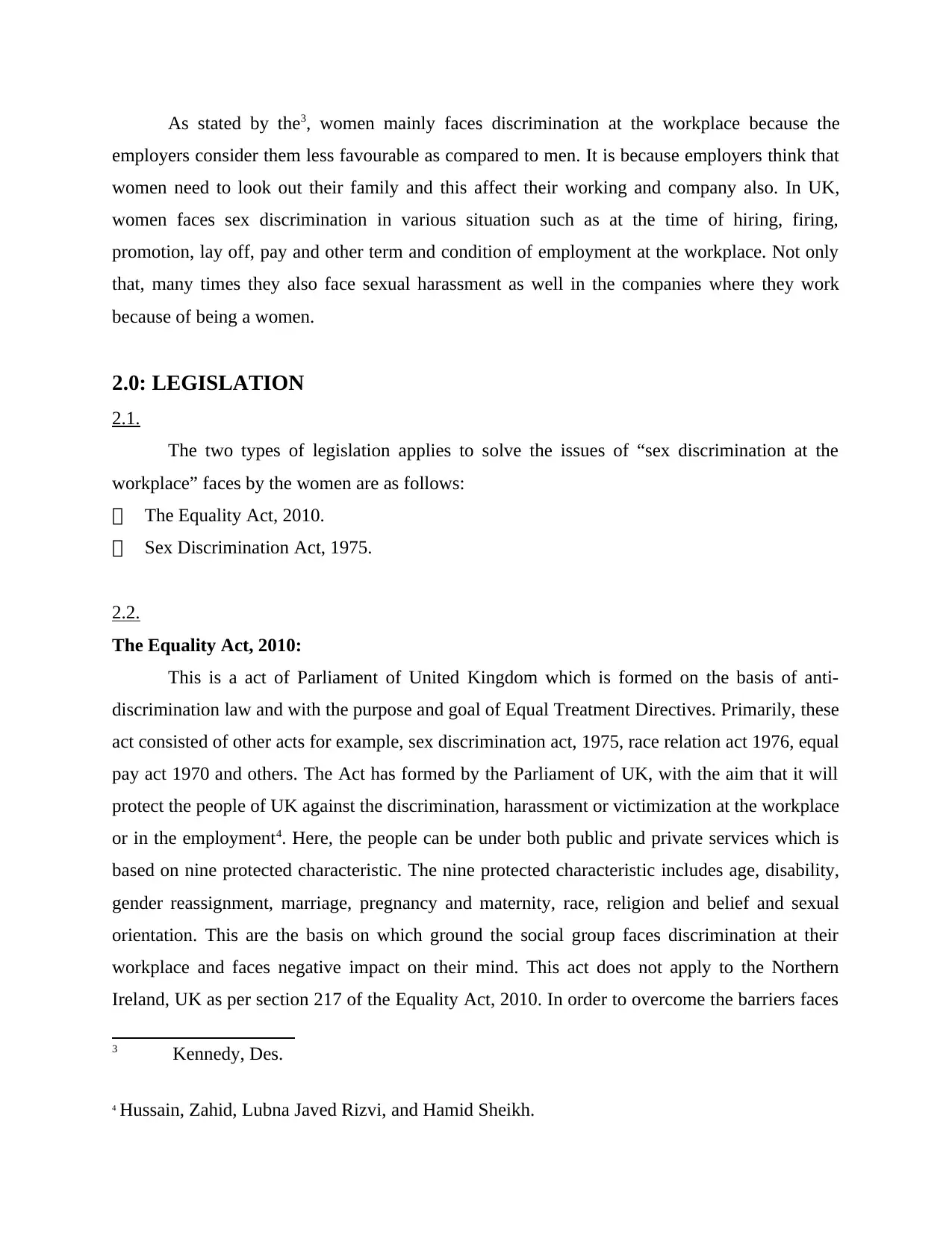
As stated by the3, women mainly faces discrimination at the workplace because the
employers consider them less favourable as compared to men. It is because employers think that
women need to look out their family and this affect their working and company also. In UK,
women faces sex discrimination in various situation such as at the time of hiring, firing,
promotion, lay off, pay and other term and condition of employment at the workplace. Not only
that, many times they also face sexual harassment as well in the companies where they work
because of being a women.
2.0: LEGISLATION
2.1.
The two types of legislation applies to solve the issues of “sex discrimination at the
workplace” faces by the women are as follows:
The Equality Act, 2010.
Sex Discrimination Act, 1975.
2.2.
The Equality Act, 2010:
This is a act of Parliament of United Kingdom which is formed on the basis of anti-
discrimination law and with the purpose and goal of Equal Treatment Directives. Primarily, these
act consisted of other acts for example, sex discrimination act, 1975, race relation act 1976, equal
pay act 1970 and others. The Act has formed by the Parliament of UK, with the aim that it will
protect the people of UK against the discrimination, harassment or victimization at the workplace
or in the employment4. Here, the people can be under both public and private services which is
based on nine protected characteristic. The nine protected characteristic includes age, disability,
gender reassignment, marriage, pregnancy and maternity, race, religion and belief and sexual
orientation. This are the basis on which ground the social group faces discrimination at their
workplace and faces negative impact on their mind. This act does not apply to the Northern
Ireland, UK as per section 217 of the Equality Act, 2010. In order to overcome the barriers faces
3 Kennedy, Des.
4 Hussain, Zahid, Lubna Javed Rizvi, and Hamid Sheikh.
employers consider them less favourable as compared to men. It is because employers think that
women need to look out their family and this affect their working and company also. In UK,
women faces sex discrimination in various situation such as at the time of hiring, firing,
promotion, lay off, pay and other term and condition of employment at the workplace. Not only
that, many times they also face sexual harassment as well in the companies where they work
because of being a women.
2.0: LEGISLATION
2.1.
The two types of legislation applies to solve the issues of “sex discrimination at the
workplace” faces by the women are as follows:
The Equality Act, 2010.
Sex Discrimination Act, 1975.
2.2.
The Equality Act, 2010:
This is a act of Parliament of United Kingdom which is formed on the basis of anti-
discrimination law and with the purpose and goal of Equal Treatment Directives. Primarily, these
act consisted of other acts for example, sex discrimination act, 1975, race relation act 1976, equal
pay act 1970 and others. The Act has formed by the Parliament of UK, with the aim that it will
protect the people of UK against the discrimination, harassment or victimization at the workplace
or in the employment4. Here, the people can be under both public and private services which is
based on nine protected characteristic. The nine protected characteristic includes age, disability,
gender reassignment, marriage, pregnancy and maternity, race, religion and belief and sexual
orientation. This are the basis on which ground the social group faces discrimination at their
workplace and faces negative impact on their mind. This act does not apply to the Northern
Ireland, UK as per section 217 of the Equality Act, 2010. In order to overcome the barriers faces
3 Kennedy, Des.
4 Hussain, Zahid, Lubna Javed Rizvi, and Hamid Sheikh.
Paraphrase This Document
Need a fresh take? Get an instant paraphrase of this document with our AI Paraphraser
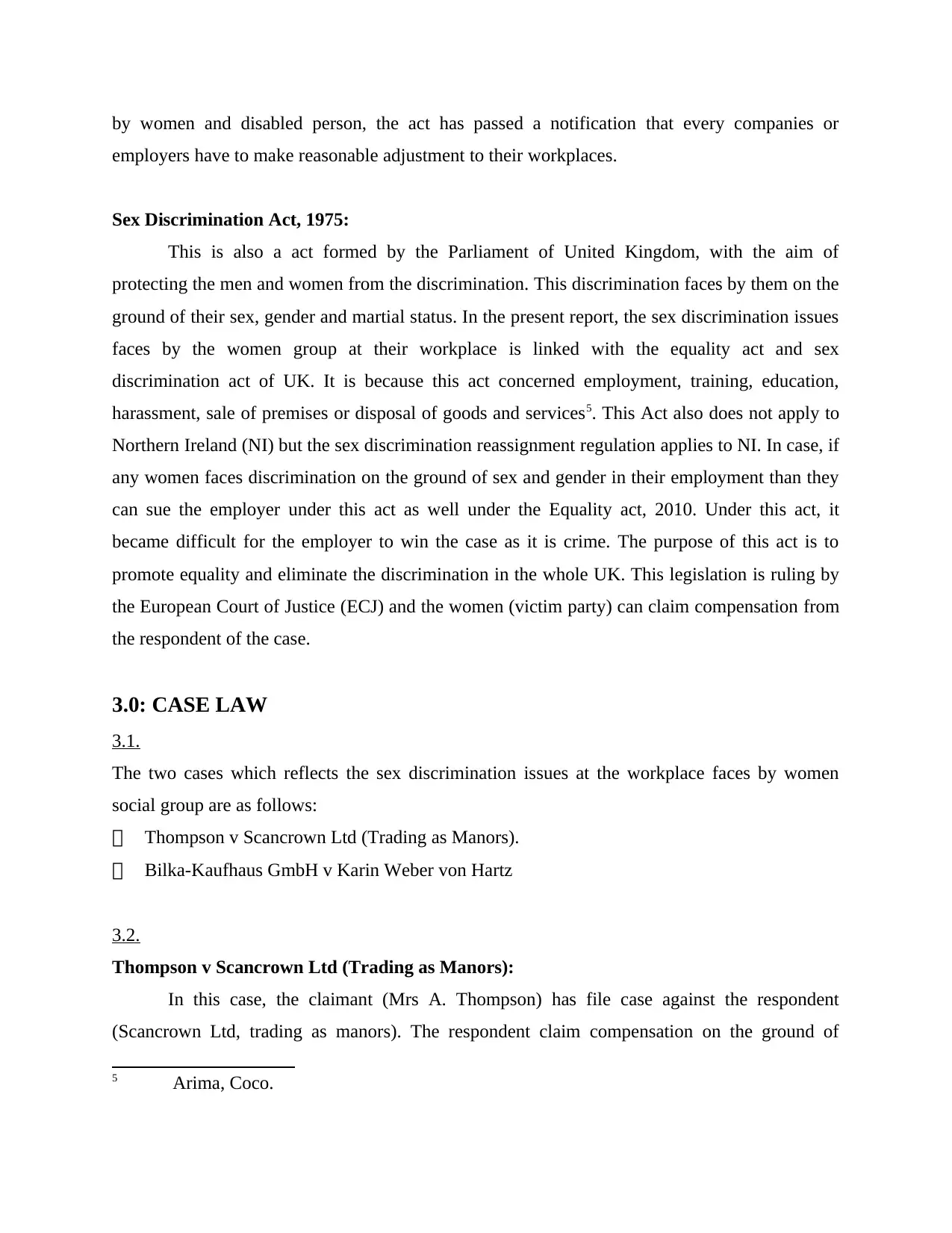
by women and disabled person, the act has passed a notification that every companies or
employers have to make reasonable adjustment to their workplaces.
Sex Discrimination Act, 1975:
This is also a act formed by the Parliament of United Kingdom, with the aim of
protecting the men and women from the discrimination. This discrimination faces by them on the
ground of their sex, gender and martial status. In the present report, the sex discrimination issues
faces by the women group at their workplace is linked with the equality act and sex
discrimination act of UK. It is because this act concerned employment, training, education,
harassment, sale of premises or disposal of goods and services5. This Act also does not apply to
Northern Ireland (NI) but the sex discrimination reassignment regulation applies to NI. In case, if
any women faces discrimination on the ground of sex and gender in their employment than they
can sue the employer under this act as well under the Equality act, 2010. Under this act, it
became difficult for the employer to win the case as it is crime. The purpose of this act is to
promote equality and eliminate the discrimination in the whole UK. This legislation is ruling by
the European Court of Justice (ECJ) and the women (victim party) can claim compensation from
the respondent of the case.
3.0: CASE LAW
3.1.
The two cases which reflects the sex discrimination issues at the workplace faces by women
social group are as follows:
Thompson v Scancrown Ltd (Trading as Manors).
Bilka-Kaufhaus GmbH v Karin Weber von Hartz
3.2.
Thompson v Scancrown Ltd (Trading as Manors):
In this case, the claimant (Mrs A. Thompson) has file case against the respondent
(Scancrown Ltd, trading as manors). The respondent claim compensation on the ground of
5 Arima, Coco.
employers have to make reasonable adjustment to their workplaces.
Sex Discrimination Act, 1975:
This is also a act formed by the Parliament of United Kingdom, with the aim of
protecting the men and women from the discrimination. This discrimination faces by them on the
ground of their sex, gender and martial status. In the present report, the sex discrimination issues
faces by the women group at their workplace is linked with the equality act and sex
discrimination act of UK. It is because this act concerned employment, training, education,
harassment, sale of premises or disposal of goods and services5. This Act also does not apply to
Northern Ireland (NI) but the sex discrimination reassignment regulation applies to NI. In case, if
any women faces discrimination on the ground of sex and gender in their employment than they
can sue the employer under this act as well under the Equality act, 2010. Under this act, it
became difficult for the employer to win the case as it is crime. The purpose of this act is to
promote equality and eliminate the discrimination in the whole UK. This legislation is ruling by
the European Court of Justice (ECJ) and the women (victim party) can claim compensation from
the respondent of the case.
3.0: CASE LAW
3.1.
The two cases which reflects the sex discrimination issues at the workplace faces by women
social group are as follows:
Thompson v Scancrown Ltd (Trading as Manors).
Bilka-Kaufhaus GmbH v Karin Weber von Hartz
3.2.
Thompson v Scancrown Ltd (Trading as Manors):
In this case, the claimant (Mrs A. Thompson) has file case against the respondent
(Scancrown Ltd, trading as manors). The respondent claim compensation on the ground of
5 Arima, Coco.
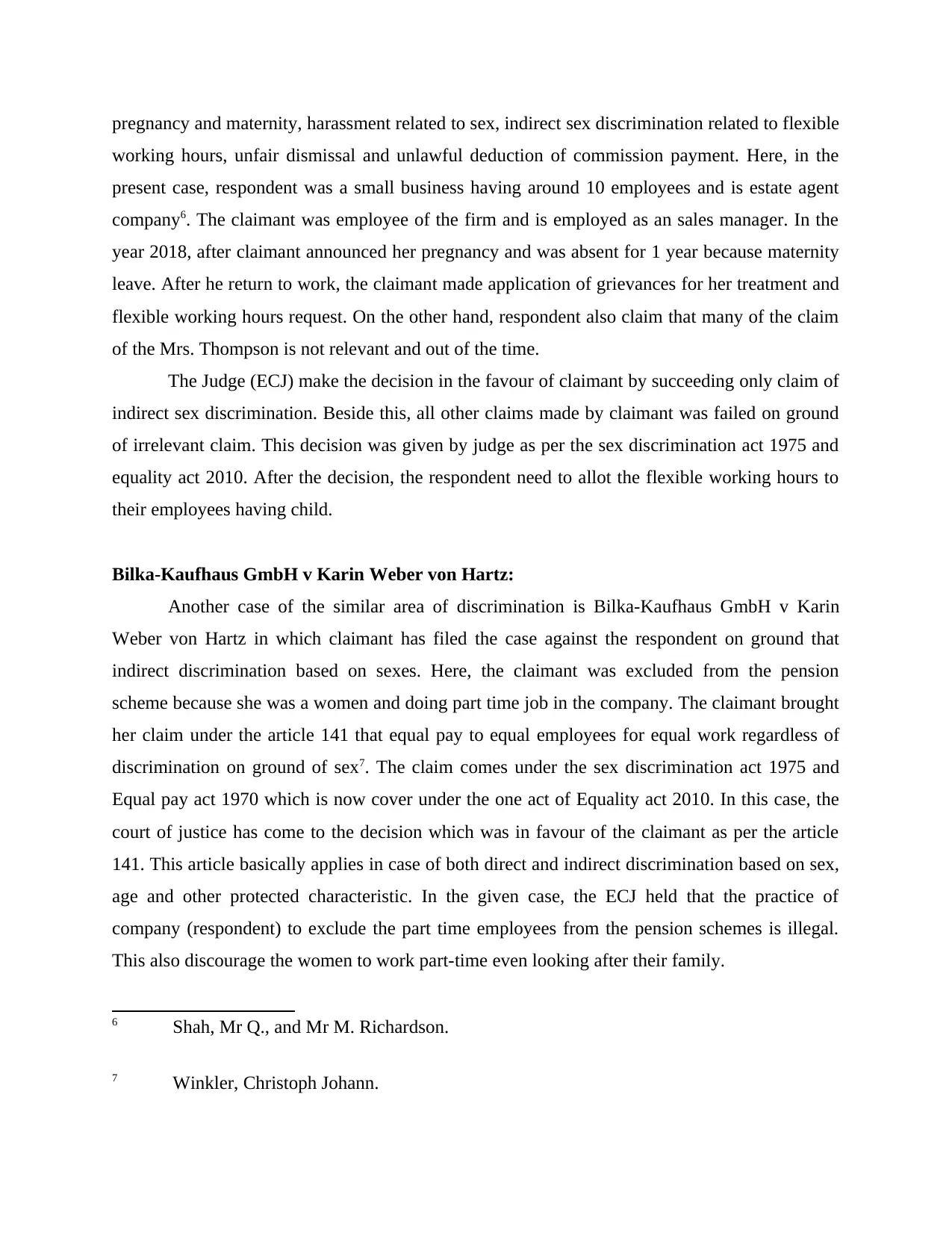
pregnancy and maternity, harassment related to sex, indirect sex discrimination related to flexible
working hours, unfair dismissal and unlawful deduction of commission payment. Here, in the
present case, respondent was a small business having around 10 employees and is estate agent
company6. The claimant was employee of the firm and is employed as an sales manager. In the
year 2018, after claimant announced her pregnancy and was absent for 1 year because maternity
leave. After he return to work, the claimant made application of grievances for her treatment and
flexible working hours request. On the other hand, respondent also claim that many of the claim
of the Mrs. Thompson is not relevant and out of the time.
The Judge (ECJ) make the decision in the favour of claimant by succeeding only claim of
indirect sex discrimination. Beside this, all other claims made by claimant was failed on ground
of irrelevant claim. This decision was given by judge as per the sex discrimination act 1975 and
equality act 2010. After the decision, the respondent need to allot the flexible working hours to
their employees having child.
Bilka-Kaufhaus GmbH v Karin Weber von Hartz:
Another case of the similar area of discrimination is Bilka-Kaufhaus GmbH v Karin
Weber von Hartz in which claimant has filed the case against the respondent on ground that
indirect discrimination based on sexes. Here, the claimant was excluded from the pension
scheme because she was a women and doing part time job in the company. The claimant brought
her claim under the article 141 that equal pay to equal employees for equal work regardless of
discrimination on ground of sex7. The claim comes under the sex discrimination act 1975 and
Equal pay act 1970 which is now cover under the one act of Equality act 2010. In this case, the
court of justice has come to the decision which was in favour of the claimant as per the article
141. This article basically applies in case of both direct and indirect discrimination based on sex,
age and other protected characteristic. In the given case, the ECJ held that the practice of
company (respondent) to exclude the part time employees from the pension schemes is illegal.
This also discourage the women to work part-time even looking after their family.
6 Shah, Mr Q., and Mr M. Richardson.
7 Winkler, Christoph Johann.
working hours, unfair dismissal and unlawful deduction of commission payment. Here, in the
present case, respondent was a small business having around 10 employees and is estate agent
company6. The claimant was employee of the firm and is employed as an sales manager. In the
year 2018, after claimant announced her pregnancy and was absent for 1 year because maternity
leave. After he return to work, the claimant made application of grievances for her treatment and
flexible working hours request. On the other hand, respondent also claim that many of the claim
of the Mrs. Thompson is not relevant and out of the time.
The Judge (ECJ) make the decision in the favour of claimant by succeeding only claim of
indirect sex discrimination. Beside this, all other claims made by claimant was failed on ground
of irrelevant claim. This decision was given by judge as per the sex discrimination act 1975 and
equality act 2010. After the decision, the respondent need to allot the flexible working hours to
their employees having child.
Bilka-Kaufhaus GmbH v Karin Weber von Hartz:
Another case of the similar area of discrimination is Bilka-Kaufhaus GmbH v Karin
Weber von Hartz in which claimant has filed the case against the respondent on ground that
indirect discrimination based on sexes. Here, the claimant was excluded from the pension
scheme because she was a women and doing part time job in the company. The claimant brought
her claim under the article 141 that equal pay to equal employees for equal work regardless of
discrimination on ground of sex7. The claim comes under the sex discrimination act 1975 and
Equal pay act 1970 which is now cover under the one act of Equality act 2010. In this case, the
court of justice has come to the decision which was in favour of the claimant as per the article
141. This article basically applies in case of both direct and indirect discrimination based on sex,
age and other protected characteristic. In the given case, the ECJ held that the practice of
company (respondent) to exclude the part time employees from the pension schemes is illegal.
This also discourage the women to work part-time even looking after their family.
6 Shah, Mr Q., and Mr M. Richardson.
7 Winkler, Christoph Johann.
⊘ This is a preview!⊘
Do you want full access?
Subscribe today to unlock all pages.

Trusted by 1+ million students worldwide
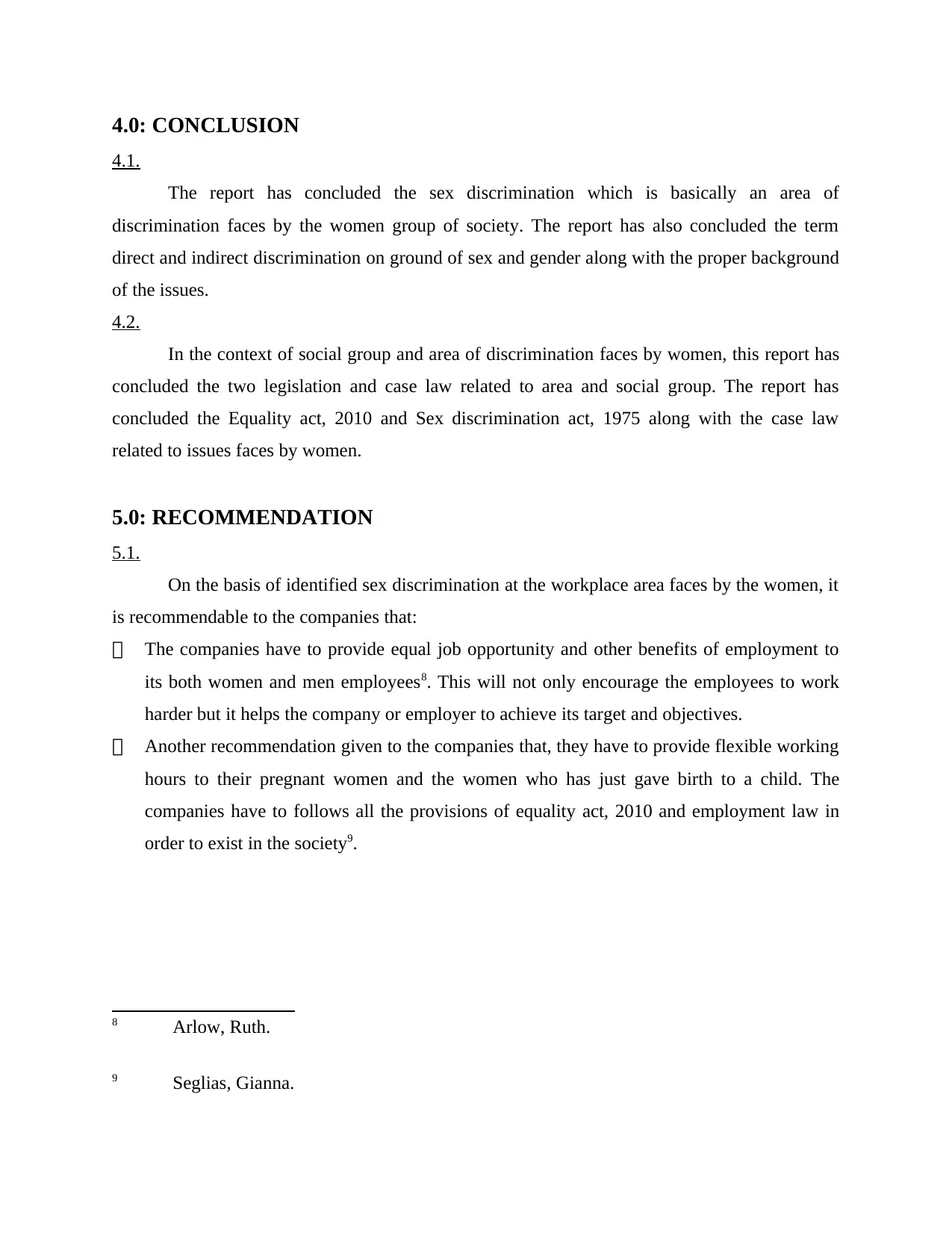
4.0: CONCLUSION
4.1.
The report has concluded the sex discrimination which is basically an area of
discrimination faces by the women group of society. The report has also concluded the term
direct and indirect discrimination on ground of sex and gender along with the proper background
of the issues.
4.2.
In the context of social group and area of discrimination faces by women, this report has
concluded the two legislation and case law related to area and social group. The report has
concluded the Equality act, 2010 and Sex discrimination act, 1975 along with the case law
related to issues faces by women.
5.0: RECOMMENDATION
5.1.
On the basis of identified sex discrimination at the workplace area faces by the women, it
is recommendable to the companies that:
The companies have to provide equal job opportunity and other benefits of employment to
its both women and men employees8. This will not only encourage the employees to work
harder but it helps the company or employer to achieve its target and objectives.
Another recommendation given to the companies that, they have to provide flexible working
hours to their pregnant women and the women who has just gave birth to a child. The
companies have to follows all the provisions of equality act, 2010 and employment law in
order to exist in the society9.
8 Arlow, Ruth.
9 Seglias, Gianna.
4.1.
The report has concluded the sex discrimination which is basically an area of
discrimination faces by the women group of society. The report has also concluded the term
direct and indirect discrimination on ground of sex and gender along with the proper background
of the issues.
4.2.
In the context of social group and area of discrimination faces by women, this report has
concluded the two legislation and case law related to area and social group. The report has
concluded the Equality act, 2010 and Sex discrimination act, 1975 along with the case law
related to issues faces by women.
5.0: RECOMMENDATION
5.1.
On the basis of identified sex discrimination at the workplace area faces by the women, it
is recommendable to the companies that:
The companies have to provide equal job opportunity and other benefits of employment to
its both women and men employees8. This will not only encourage the employees to work
harder but it helps the company or employer to achieve its target and objectives.
Another recommendation given to the companies that, they have to provide flexible working
hours to their pregnant women and the women who has just gave birth to a child. The
companies have to follows all the provisions of equality act, 2010 and employment law in
order to exist in the society9.
8 Arlow, Ruth.
9 Seglias, Gianna.
Paraphrase This Document
Need a fresh take? Get an instant paraphrase of this document with our AI Paraphraser
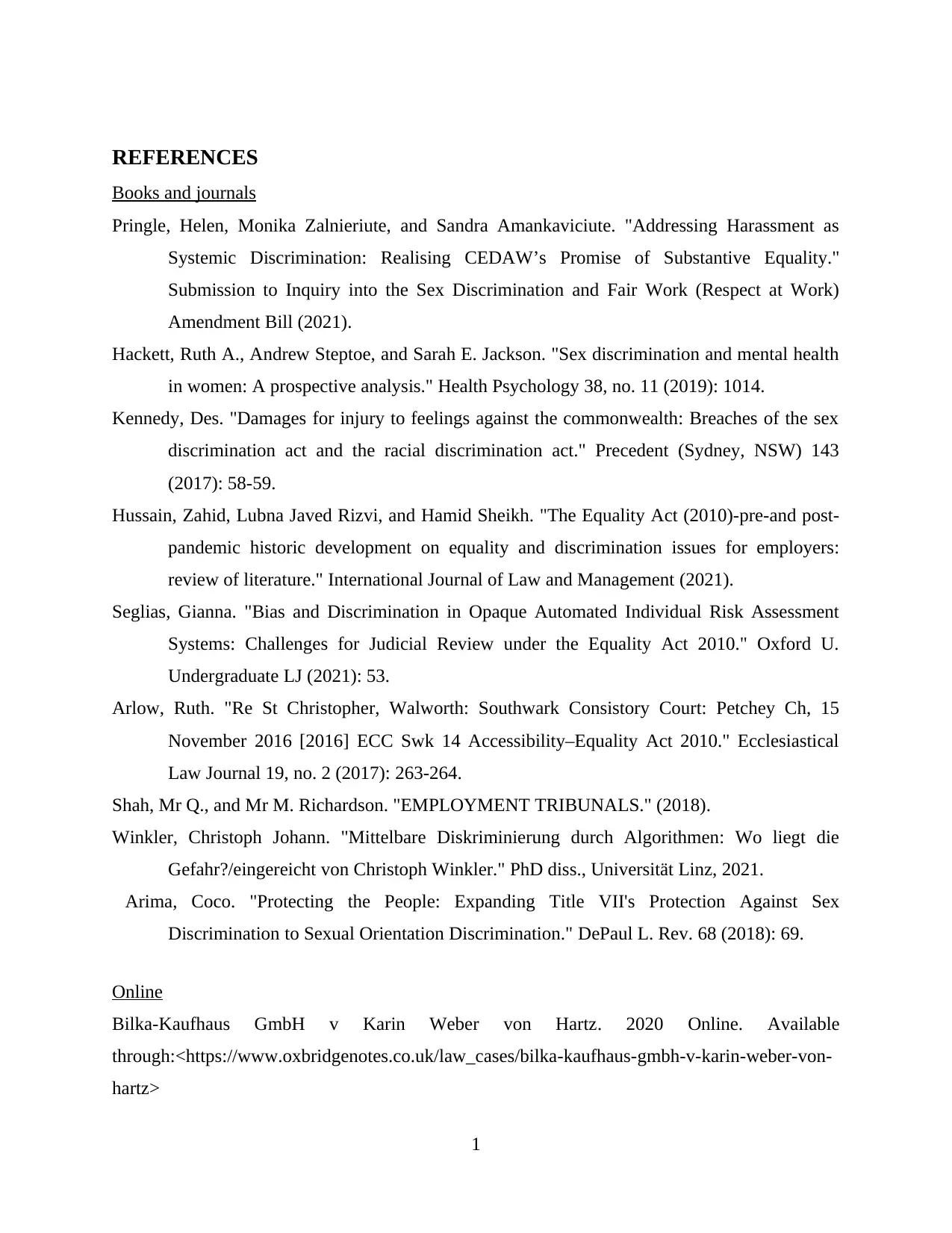
REFERENCES
Books and journals
Pringle, Helen, Monika Zalnieriute, and Sandra Amankaviciute. "Addressing Harassment as
Systemic Discrimination: Realising CEDAW’s Promise of Substantive Equality."
Submission to Inquiry into the Sex Discrimination and Fair Work (Respect at Work)
Amendment Bill (2021).
Hackett, Ruth A., Andrew Steptoe, and Sarah E. Jackson. "Sex discrimination and mental health
in women: A prospective analysis." Health Psychology 38, no. 11 (2019): 1014.
Kennedy, Des. "Damages for injury to feelings against the commonwealth: Breaches of the sex
discrimination act and the racial discrimination act." Precedent (Sydney, NSW) 143
(2017): 58-59.
Hussain, Zahid, Lubna Javed Rizvi, and Hamid Sheikh. "The Equality Act (2010)-pre-and post-
pandemic historic development on equality and discrimination issues for employers:
review of literature." International Journal of Law and Management (2021).
Seglias, Gianna. "Bias and Discrimination in Opaque Automated Individual Risk Assessment
Systems: Challenges for Judicial Review under the Equality Act 2010." Oxford U.
Undergraduate LJ (2021): 53.
Arlow, Ruth. "Re St Christopher, Walworth: Southwark Consistory Court: Petchey Ch, 15
November 2016 [2016] ECC Swk 14 Accessibility–Equality Act 2010." Ecclesiastical
Law Journal 19, no. 2 (2017): 263-264.
Shah, Mr Q., and Mr M. Richardson. "EMPLOYMENT TRIBUNALS." (2018).
Winkler, Christoph Johann. "Mittelbare Diskriminierung durch Algorithmen: Wo liegt die
Gefahr?/eingereicht von Christoph Winkler." PhD diss., Universität Linz, 2021.
Arima, Coco. "Protecting the People: Expanding Title VII's Protection Against Sex
Discrimination to Sexual Orientation Discrimination." DePaul L. Rev. 68 (2018): 69.
Online
Bilka-Kaufhaus GmbH v Karin Weber von Hartz. 2020 Online. Available
through:<https://www.oxbridgenotes.co.uk/law_cases/bilka-kaufhaus-gmbh-v-karin-weber-von-
hartz>
1
Books and journals
Pringle, Helen, Monika Zalnieriute, and Sandra Amankaviciute. "Addressing Harassment as
Systemic Discrimination: Realising CEDAW’s Promise of Substantive Equality."
Submission to Inquiry into the Sex Discrimination and Fair Work (Respect at Work)
Amendment Bill (2021).
Hackett, Ruth A., Andrew Steptoe, and Sarah E. Jackson. "Sex discrimination and mental health
in women: A prospective analysis." Health Psychology 38, no. 11 (2019): 1014.
Kennedy, Des. "Damages for injury to feelings against the commonwealth: Breaches of the sex
discrimination act and the racial discrimination act." Precedent (Sydney, NSW) 143
(2017): 58-59.
Hussain, Zahid, Lubna Javed Rizvi, and Hamid Sheikh. "The Equality Act (2010)-pre-and post-
pandemic historic development on equality and discrimination issues for employers:
review of literature." International Journal of Law and Management (2021).
Seglias, Gianna. "Bias and Discrimination in Opaque Automated Individual Risk Assessment
Systems: Challenges for Judicial Review under the Equality Act 2010." Oxford U.
Undergraduate LJ (2021): 53.
Arlow, Ruth. "Re St Christopher, Walworth: Southwark Consistory Court: Petchey Ch, 15
November 2016 [2016] ECC Swk 14 Accessibility–Equality Act 2010." Ecclesiastical
Law Journal 19, no. 2 (2017): 263-264.
Shah, Mr Q., and Mr M. Richardson. "EMPLOYMENT TRIBUNALS." (2018).
Winkler, Christoph Johann. "Mittelbare Diskriminierung durch Algorithmen: Wo liegt die
Gefahr?/eingereicht von Christoph Winkler." PhD diss., Universität Linz, 2021.
Arima, Coco. "Protecting the People: Expanding Title VII's Protection Against Sex
Discrimination to Sexual Orientation Discrimination." DePaul L. Rev. 68 (2018): 69.
Online
Bilka-Kaufhaus GmbH v Karin Weber von Hartz. 2020 Online. Available
through:<https://www.oxbridgenotes.co.uk/law_cases/bilka-kaufhaus-gmbh-v-karin-weber-von-
hartz>
1

EMPLOYMENT TRIBUNALS. 2020. Online. Available
through:<https://assets.publishing.service.gov.uk/media/60a375d3d3bf7f2888d19089/
Mrs_A_Thompson__vs__Scancrown_Ltd_trading_as_Manors.pdf>
2
through:<https://assets.publishing.service.gov.uk/media/60a375d3d3bf7f2888d19089/
Mrs_A_Thompson__vs__Scancrown_Ltd_trading_as_Manors.pdf>
2
⊘ This is a preview!⊘
Do you want full access?
Subscribe today to unlock all pages.

Trusted by 1+ million students worldwide
1 out of 9
Related Documents
Your All-in-One AI-Powered Toolkit for Academic Success.
+13062052269
info@desklib.com
Available 24*7 on WhatsApp / Email
![[object Object]](/_next/static/media/star-bottom.7253800d.svg)
Unlock your academic potential
Copyright © 2020–2025 A2Z Services. All Rights Reserved. Developed and managed by ZUCOL.




